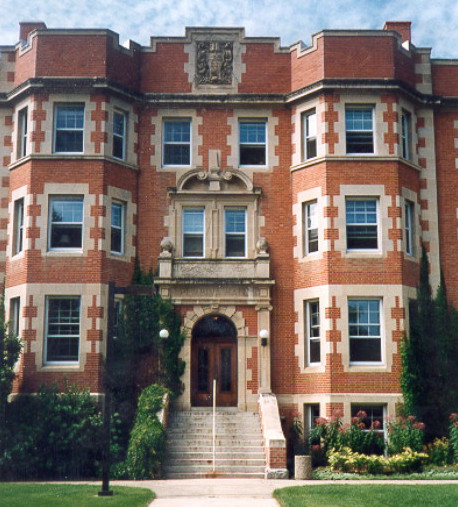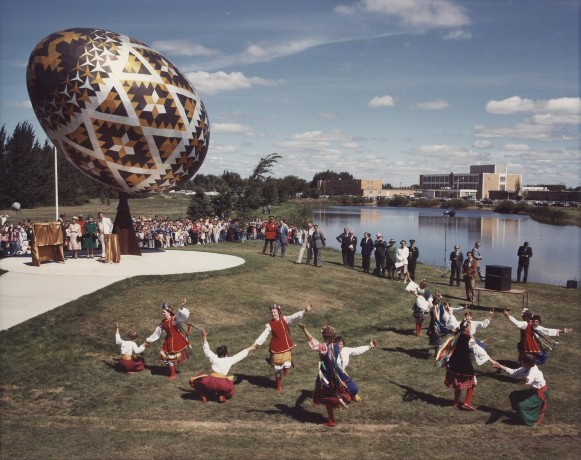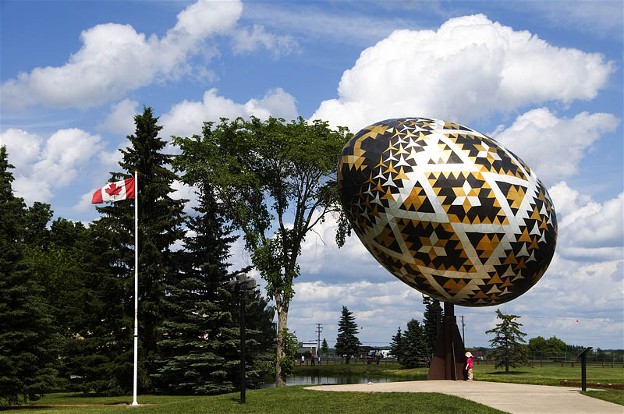Alberta
Alberta (Альберта). The western-most prairie province in Canada, with an area of 661,848 sq km and a population in 2006 of 3,256,355. Alberta’s climate is continental. The southern part of the province consists of flat prairie, while the central region evolves through aspen parkland into boreal forest in the north. The Rocky Mountains run along the western border with British Columbia. Agriculture was the mainstay of the provincial economy until the mid-1940s; since then there has been considerable diversification as a result of the development of the oil industry, food processing, and manufacturing. The provincial capital is Edmonton.
In 2006 there were 332,180 people of Ukrainian origin in the province, constituting 10.2 percent of the population; 249,990 were of mixed background. In the 2006 census, 31,265 Albertans claimed Ukrainian as their mother tongue. The largest concentrations of Ukrainian Canadians in Alberta are in Edmonton (144,620) and Calgary (76,240).
Ukrainians first came to Alberta in the early 1890s; the first documented Ukrainian immigrant was Ivan Pylypow in 1891. The majority of these settlers homesteaded northeast of Edmonton, where a compact bloc (originally referred to as a “colony”) of Ukrainian settlement developed; by 1914 it stretched for 110 km from Edna-Star in the west to Slawa in the east and approx 70 km from Smoky Lake in the north to the outskirts of Mundare and Vegreville in the south. Virtually all of Alberta’s earliest Ukrainian settlers came from the Western Ukrainian regions of Galicia and Bukovyna. The bloc-settlement district of east central Alberta was the largest “colony” of its kind in Canada, and its Ukrainian character was reflected in place-names such as Zhoda, Myrnam, Buczacz, Borshchiw, New Kiew, and so forth. Before the First World War, small rural Ukrainian settlement pockets were also established south of Edmonton near Leduc and southeast of Edmonton in the Round Hill district. Edmonton was the main urban settlement area for Ukrainians in this period, although in absolute terms their numbers were small. Ukrainians could also be found in the mining communities of the Crowsnest Pass as well as in Lethbridge, Drumheller, and Calgary. During the interwar period, a significant number of new arrivals were attracted to homestead lands in the Athabasca and Peace River areas. A larger number, however, tended to find work as farm laborers in the original bloc settlement and in rural offshoots that evolved adjacent to it. The relatively smaller number of Ukrainian immigrants who have come to Alberta since the Second World War have overwhelmingly tended to settle in the province’s cities.
The first wave of Ukrainian immigrants to Alberta consisted predominantly of agriculturalists, many of whom found seasonal employment in other jobs to finance the establishment of their farmsteads. A minority worked as laborers in the cities or as miners. In the interwar period a small but growing number of Ukrainians began businesses or entered professional occupations. Since the Second World War the general socioeconomic profile of Ukrainians has come to reflect that of Albertan society at large.
Churches were commonly the first community structures to be erected in Ukrainian settlement areas. The majority of Ukrainians in Alberta belonged to the Ukrainian Catholic church, which established the Edmonton eparchy in 1956 (it was preceded by the Exarchate of Western Canada from 1948 to1956). Until the mid-1940s almost all the Ukrainian Catholic priests in the province belonged to the Basilian monastic order, a situation that changed only after the arrival of European-born priests in the postwar period. The first Basilians came to Alberta in 1902 and established themselves near Mundare, where the order built its monastery in 1923. The Golgotha grotto beside that monastery has provided the focus for a popular annual pilgrimage for many years. Edmonton eparchy has been administered by Bishops Nil Savaryn (1956–86, exarch 1948–56), Demetrius Greschuk (1986–90), Myron Daciuk (1991–6), and Lawrence Huculak (1997–2006), and David Motiuk (2007–).
The churches that Alberta’s Orthodox Ukrainians founded were initially served by priests of the Russian Orthodox mission in North America. Although primarily comprised of Bukovynians, some pioneer-era Orthodox congregations were also started by settlers influenced by the turn-of-the century Russophile movement in Austrian-ruled Galicia. With the inauguration of missionary activity by the Ukrainian Orthodox Church of Canada (UOC) in 1920, many Russo-Orthodox adherents switched their allegiance to the UOC, which also attracted a following among disenchanted Catholics. Owing to these defections, during the interwar period the UOC became the pre-eminent Orthodox church among Ukrainians in Alberta, the Russian Orthodox Church (ROC) having been further weakened by the collapse of the Russian tsarist regime and the attendant loss of material support from the ROC there. In 1959 the Ukrainian Orthodox church created a Western diocese, incorporating Alberta and British Columbia, with Bishop Andrei (Hryhorii Metiuk) assuming the new episcopal throne. He was succeeded by Bishop Ivan (John Stinka) in 1983, and then Ilarion Rudnyk in 2008.
The earliest Ukrainian community organizations in Alberta tended to be Prosvita society-style cultural-educational groups, many of which supported choirs and/or theater troupes. Almost all of these groups operated initially out of rented premises. But in the 1920s and 1930s they began building their own facilities, resulting in a network of 120 Ukrainian community halls throughout the province. In this same period the ideological differences among these groups became more pronounced, and they established formal or informal ties with a growing number of nation-wide Ukrainian organizations. Many of the halls in farming areas were closed down after the Second World War as a result of rural depopulation and the establishment of new municipal facilities. Organized Ukrainian activity subsequently tended to focus around the churches and major national Ukrainian associations. Since the 1970s there has been a trend toward establishing activity-specific groups and a return to general cultural societies. The Alberta Provincial Council of the Ukrainian Canadian Congress acts as an umbrella body for the province’s Ukrainian organizations.
Alberta’s Ukrainians have had a strong political record. Their first major entry into provincial politics was in 1913, when they elected Andrew Shandro to the province’s Legislative Assembly (somewhat ironically, as he was an ‘establishment’ candidate running against a community-minded opponent). In 1921 Wasyl Fedun was elected to the assembly; he was followed by Michael Chornohus in a 1922 by-election. Subsequently, Ukrainian candidates were elected routinely, initially aided by the ethnic vote in heavily Ukrainian constituencies, but over time primarily on their own merit. The first ethnic Ukrainian member of the Canadian Parliament—Michael Luchkovich (1926–35)—was elected in the Vegreville consituency. Other Ukrainian-Canadian members of Parliament from Alberta include Anthony Hlynka (1940–9), John Decore (1949–57), Ambrose Holowach (1953–8), William Skoreyko (1958–74), and Steve Paproski (1968–93). Provincial Legislative Assembly members of Ukrainian origin include Peter Miskew (1930–5), Isidore Goresky (1930–5), William Tomyn (1935–52 and 1959–71), Ambrose Holowach (1959–71), William Yurko (1969–84), Wasyl Diachuk (1971–87), Albert Hohol (1971–9), Julian Koziak (1971–86), and Gene Zwozdesky (1993–2015). Two of Edmonton’s mayors—William Hawrelak (1952–9, 1963–5, and 1974–5) and Laurence Decore (1983–8, after which he headed the Liberal party in Alberta until 1994)—were of Ukrainian origin. Peter Savaryn is a former president of the Progressive Conservative Association of Alberta and a former chancellor of the University of Alberta. In 2006, Ed Stelmach (an MLA since 1993) became premier of Alberta after he was elected as leader of the Progressive Conservative party.
Publishing activity in Alberta has been largely on a regional basis, starting with such newspapers as Nova hromada (Edmonton) (1911–12) and Novyny (1913–22) and a string of papers put out by Toma Tomashevsky. The major Ukrainian news source in Alberta has been the (now bilingual) Ukraïns’ki visti/Ukrainian News, which has been published continuously since 1928.
Alberta’s Ukrainians have demonstrated a strong sense of history. Illia Kiriak wrote an epic trilogy about the Ukrainian pioneer experience, Syny zemli (Sons of the Soil, 1939–45), based on information gathered in the Alberta bloc settlement district. A former Alberta school teacher, Vasyl Chumer, was the first to try writing a serious history of Ukrainians in Canada; it appeared in 1942, a year after the establishment of the Ukrainian Pioneers’ Association of Alberta. The Edmonton-based journal Ukraïns’kyi pioner (1955–60) later continued in these efforts. In 1974 the Ukrainian Canadian Archives and Museum of Alberta was established in Edmonton, and in 1975 the Government of Alberta created the open-air Ukrainian Cultural Heritage Village approx 50 km east of Edmonton. In 1977 Myrna Kostash published All of Baba’s Children, which included accounts of Ukrainian life in the province. Since 1992 the historic Ukrainian bloc settlement area has been part of the Kalyna Country Ecomuseum.
Bilingual Ukrainian-English schools existed in Alberta until 1913, when they were banned as a result of a nativist backlash. Ukrainian-language education then became the exclusive realm of Ukrainian-community Saturday schools, It was gradually reintroduced into the public education sphere after the Second World War. In 1959 Ukrainian was allowed as a subject of instruction in Alberta’s secondary schools, and in 1974 Ukrainian-English bilingual education was re-established at the primary level (and later extended to the intermediate and secondary levels).
In 1957 Ukrainian courses were introduced into the Department of Slavic Studies at the University of Alberta (UofA). Subsequently the UofA became a world-renowned institution in the field of Ukrainian studies as a result of its Ukrainian language and literature studies core (now within the Department of Modern Languages and Cultural Studies), the establishment of the Canadian Institute of Ukrainian Studies (CIUS) in 1976, and the creation of the Huculak Chair of Ukrainian Culture and Ethnography in 1989. The UofA Department of History has included a number of outstanding professors and graduate students in Ukrainian and Ukrainian-Canadian history.
A large number of significant Ukrainian cultural figures have come from or worked in Alberta, including the artists Yuliian Butsmaniuk, William Kurelek, Peter Lipinski, Ronald Kostyniuk, and Peter Shostak and the writers Jars Balan, Illia Kiriak, Myrna Kostash, Gloria Kupchenko-Frolick, George Melnyk, Helen Potrebenko, George Ryga, Yar Slavutych, and Yurii Stefanyk (Klenovy).
Since 1991 Alberta’s ties with now independent Ukraine have increased dramatically. Several significant projects in Ukraine were initiated by Edmonton’s Grant MacEwan College (which now has regular programs in Kyiv. The Canada-Ukraine Legislative and Intergovernmental Project has been administered by the CIUS since 1995, and the Government of Alberta has established and Advisory Committee on Alberta-Ukraine Relations. In May 2002 Alberta’s then premier, Ralph Klein, led a major provincial trade mission to Ukraine. He also paid a visit in July 2006.
BIBLIOGRAPHY
Humenna, D. Vichni vohni Al’berty (Edmonton 1959)
MacGregor, J.G. Vilni Zemli-Free Lands: The Ukrainian Settlement of Alberta (Toronto 1969)
Ukrainian Pioneers’ Association of Alberta. The Ukrainian Pioneers in Alberta, Canada (Edmonton 1970)
—. Ukrainians in Alberta, 2 vols (Edmonton 1975–81)
Kostash, M. All of Baba’s Children (Edmonton 1977)
Potrebenko, H. No Streets of Gold: A Social History of Ukrainians in Alberta (Vancouver 1977)
Martynowych, O. The Ukrainian Bloc Settlement in East Central Alberta, 1890–1930: A History, Alberta Historic Sites Service Occasional Paper, no. 10 (Edmonton 1985)
Lupul, M. (ed). Continuity and Change: The Cultural Life of Alberta’s First Ukrainians (Edmonton 1988)
Slavutych, Ia. (ed). Zakhidnokanads’kyi zbirnyk 4 (Edmonton 2000)
Andrij Makuch
[This article was updated in 2009.]




.jpg)